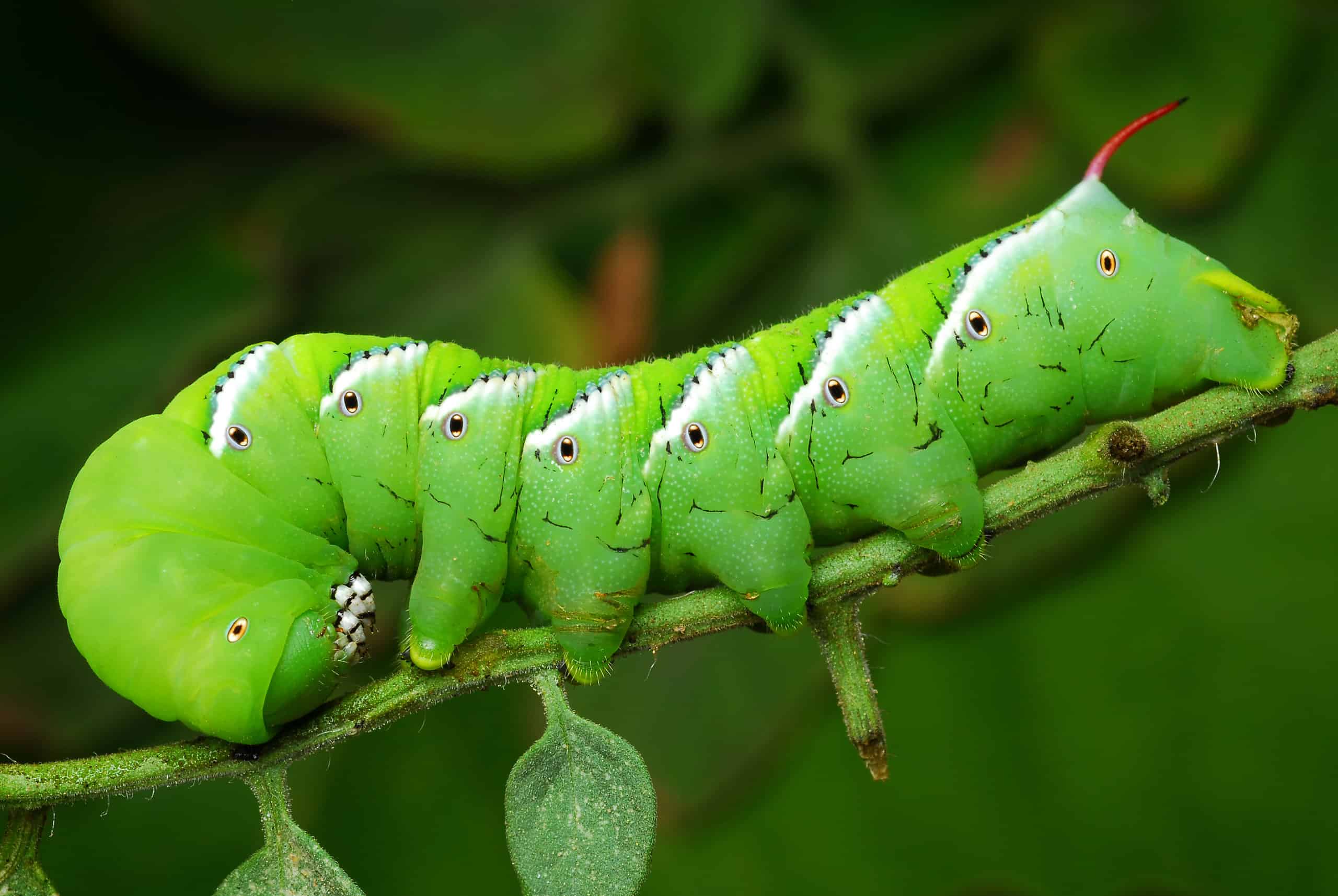Caterpillars have always fascinated people. How do these lowly, wormlike creatures, whose sole purpose is to eat and grow fat, transform into beautiful butterflies and moths? Even now, scientists don’t know exactly how the drastic change from caterpillar to butterfly occurs.
Some Things to Know About Caterpillars
Caterpillars can take as little as a week to be ready to pupate or as long as several months. Those who take a long time to mature estivate during the dry season or hibernate over the winter. As the caterpillar grows, it molts, or sheds its skin. It is called an instar in between these molts, and the first instars of a caterpillar sometimes look very different from the last ones. This can be seen in the eastern tiger swallowtail.
Butterfly and moth larvae range in size from a fraction of an inch to 6 inches when they’re mature. Some have smooth, thin skin while others are brightly colored and full of knobs, horns, and bumps. Others have spines or hair, and the hairs and spines of a few caterpillars are poisonous and can cause terrible pain if you touch them. Fortunately, these poisonous spines and hairs are lost as the caterpillar transitions to an adult.
The caterpillar’s body is divided into the head, the thorax, and the abdomen, and these divisions have segments. Its real legs emerge from the thorax, and prolegs are found in the abdomen. The caterpillar’s last segment, which is usually the 10th, has the largest prolegs. These are called the anal prolegs.
Here are a few caterpillars found in South Carolina, including a few that are poisonous. If you see those, don’t touch them!
1. Zebra Swallowtail
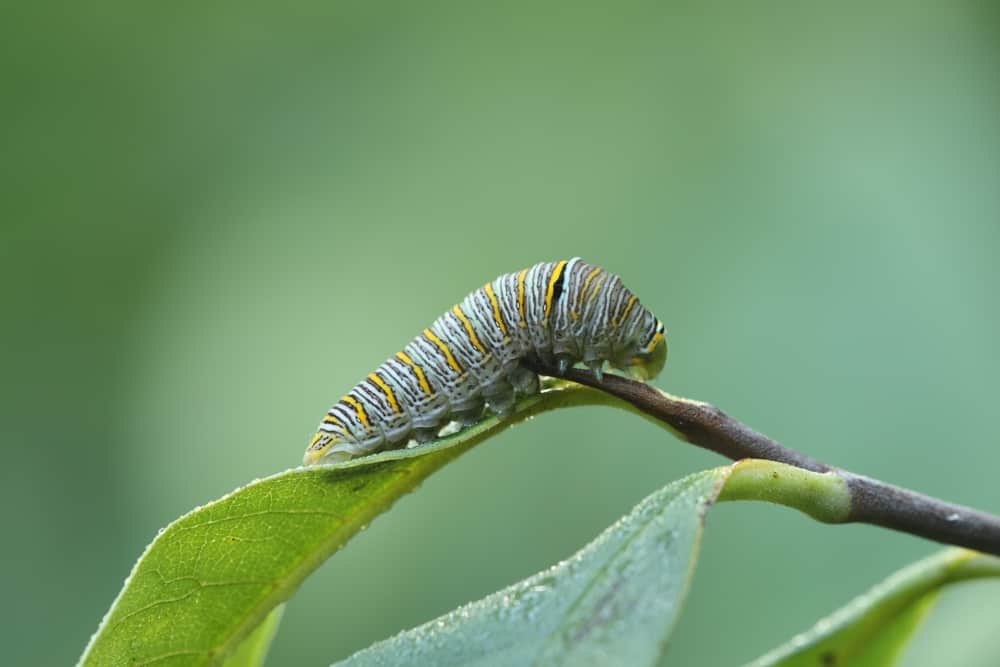
The pretty zebra swallowtail caterpillar uses the pawpaw as a food plant.
©Kevin Collison/Shutterstock.com
The caterpillar of the beautiful zebra swallowtail butterfly is also beautiful in its own way. It has a robust body with narrow black, white, pale green, and yellow stripes that are close together. The caterpillar’s body is widest at its head then tapers toward its tail. It grows to 1.96 inches and is found nearly exclusively on the pawpaw, a tree that thrives in South Carolina. It’s found near bodies of water, wet woods, and swamps. The butterfly may have three broods in South Carolina’s Low Country, and you may see this caterpillar there all year.
2. Cloudless Sulphur
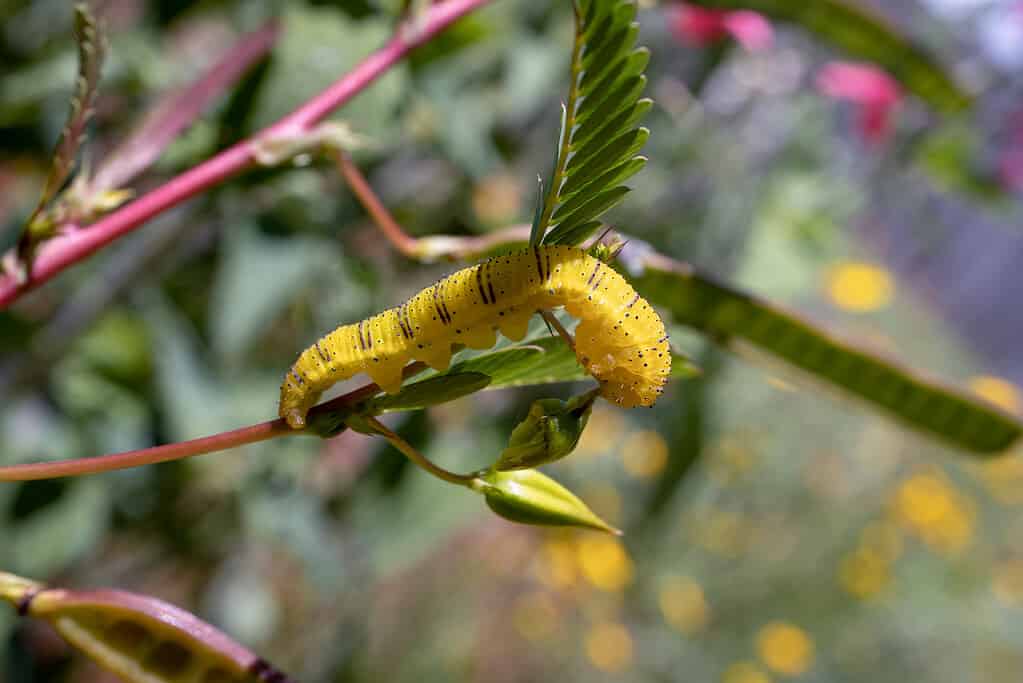
The cloudless sulphur caterpillar can be green or yellow.
©DrWD40/ via Getty Images
This caterpillar comes in a range of colors, from shades of yellow to green. It usually has a green or yellow stripe that passes through its spiracles. Spiracles are small holes in the middle of the caterpillar’s bodily segments that allow it to breathe. The bands are topped with purplish black speckles, and you’ll find six rows of purplish black tubercles at the top of the body. The caterpillar has a round, green head with black spots.
The cloudless sulphur caterpillar grows to 1.96 inches and is found at the edge of the woods, roadsides, hummocks, along bodies of water, and in swamps. Its preferred food plants are legumes, including partridge peas.
3. Puss Caterpillar
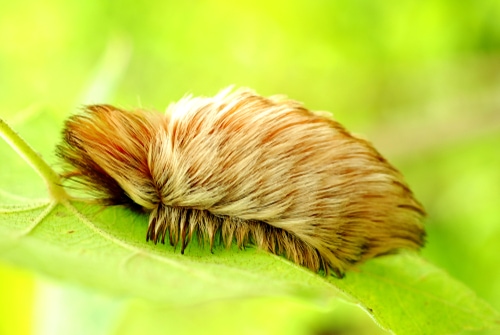
Brushing up against the puss caterpillar can send some people to the emergency room.
©Adriana Margarita Larios Arellano/Shutterstock.com
This is one caterpillar that you don’t want to mess with. It’s one of the flannel moths, whose caterpillars are covered with stinging hairs. The brown and gray hairs of the puss caterpillar are especially long and dense, rather like the fur of a tiny mammal. Though the caterpillar is less than 1.18 inches long, its sting is unforgettable. People who start to experience symptoms of anaphylactic shock after touching this caterpillar need to seek medical care right away.
Besides being furry, the puss caterpillar has a body that tapers toward the end. It even has hairs that form what looks like a tail. It’s found in South Carolina’s woods and forests, and people get stung just by inadvertently brushing up against it. The puss caterpillar eats a variety of plants, including pecans, persimmons, birches, apples, and roses.
4. Saddleback Caterpillar
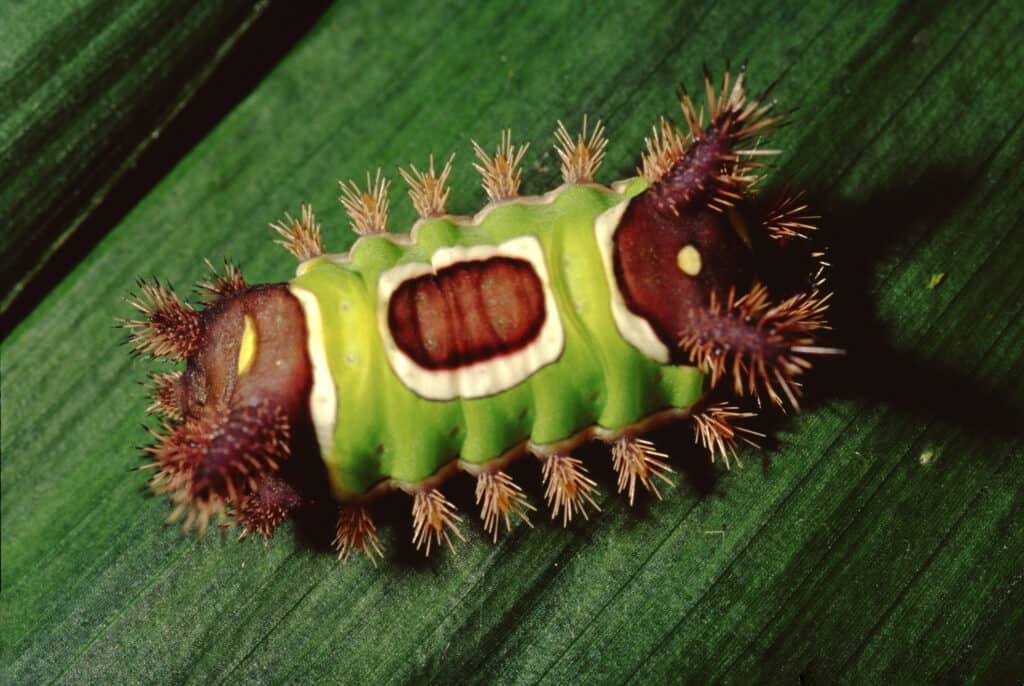
This South Carolina caterpillar has a nasty sting but turns into a drab, harmless moth.
©Liz Weber/Shutterstock.com
The saddleback caterpillar is one of the slug caterpillars because of its shape. It gets its name from the “saddle” or lime green, white-lined patch with a white-edged purple-brown oval in its center. It is also one of the poison caterpillars and packs a memorable sting. The stingers are found on the sides and at the ends of the caterpillar’s body. Younger instars have notably long stingers. When the caterpillar is attacked, it arches its body to make sure that the stingers connect.
The caterpillar is mature when it’s about 1.18 inches long. It’s a generalist when it comes to food plants, and you’ll find it in gardens, fields, the woods, and the edges of wetlands. It incorporates its stingers in its cocoon, so even the cocoon may be hazardous to handle. But in the end, what emerges is a brown, harmless moth.
5. Spun Glass Slug
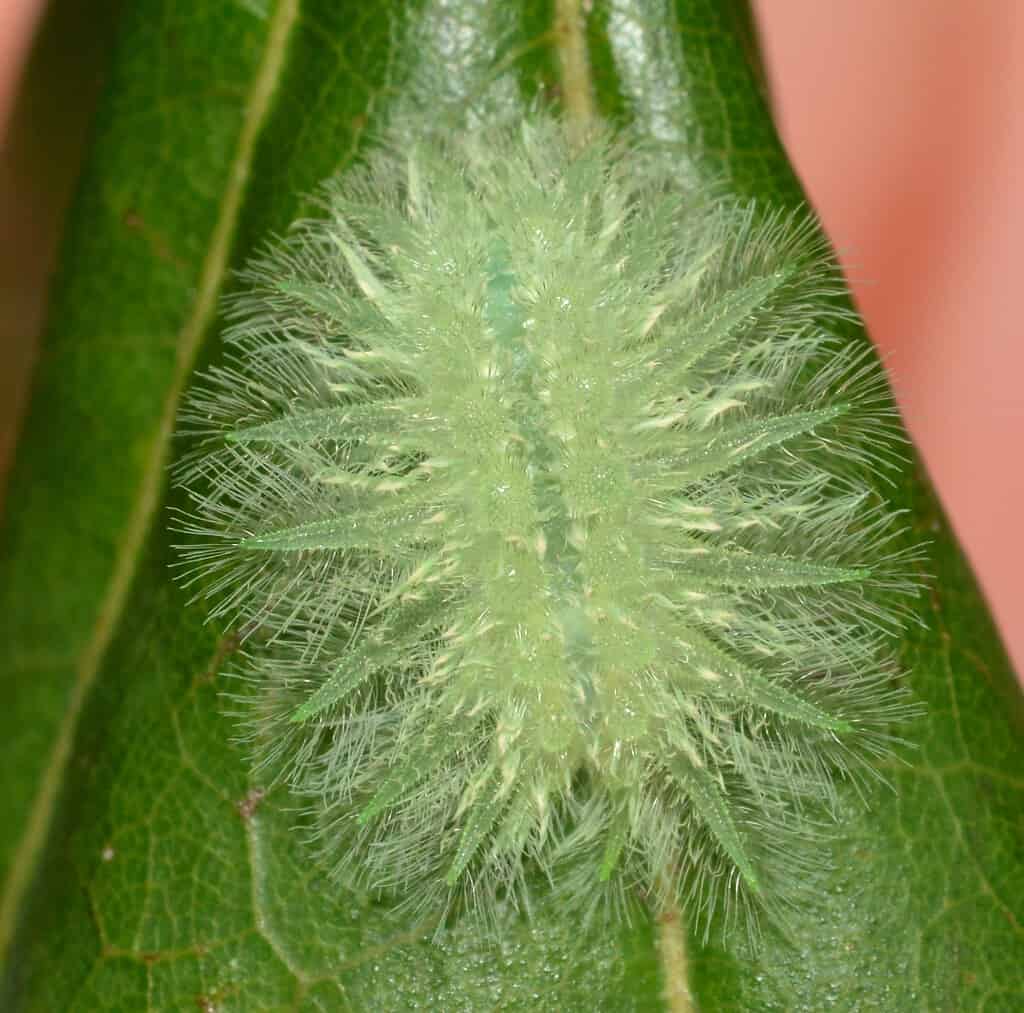
The spun glass slug turns into a rather drab brown moth, but it’s uncommonly beautiful as a larva.
©Andy Reago & Chrissy McClarren / CC BY 2.0 – Original / License
The late instar of this unusual, beautiful slug is a transparent green with 18 “arms” around its body. If you look closely, you can see its internal organs. A greenish stripe runs the length of the caterpillar’s body edged by knobs that bear stinging spines. The caterpillar’s last instar has a body covered with lobes and hairs that resemble, as the name says, spun glass. As it moves, the caterpillar leaves a trail of slime much like a real slug, and this is how you can find it. Be sure not to touch it, however.
The spun glass slug lives in forests and woodlands and in the Low Country there might be two generations. The slug’s favorite food plants are oak and beech.
6. Tobacco Hornworm
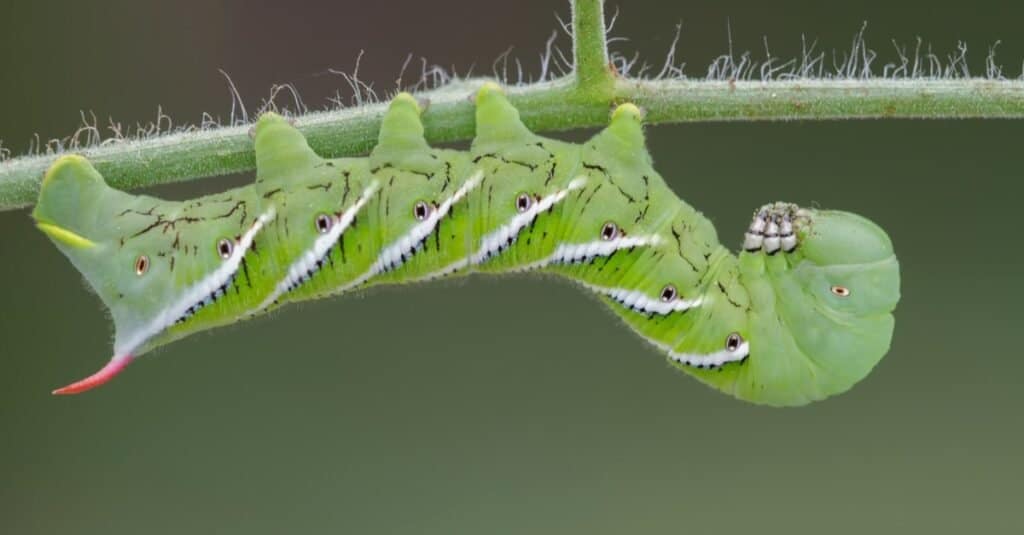
This caterpillar is murder on tomatoes, tobacco, and other nightshades.
©vbalson/Shutterstock.com
This pest is notoriously hard to find when it attacks a tomato, tobacco, or any other nightshade plant, for it is nearly the color of the plant and often does its damage from the underside. You’ll probably notice that your plant is missing leaves, stems, or flowers, or you’ll see the caterpillar’s unusually large frass before you find the culprit. Detection is made even more frustrating because the tobacco hornworm grows to be quite large. A mature hornworm can be 3.5 inches long.
The caterpillar gets its name because of the pink, red, or orange horn at the end of its body. This horn looks like a stinger but it’s not, and the caterpillar is not poisonous. Though it’s usually green, there are brown individuals. They all have seven white slashes that pass just above the spiracles, and their anal plate is edged with yellow. Its anal prolegs have evolved to hold on tightly to stems while it feeds. One way to get rid of the hornworm besides pulling it off and feeding it to the birds is to use braconid wasps. These wasps lay their eggs inside the caterpillar. Eventually, the larvae eat their way out and kill the pest. In the end, the hornworm turns into an interesting moth called the Carolina Sphinx.
7. Luna Moth

This nearly translucent green caterpillar turns into one of South Carolina’s most beautiful moths.
©iStock.com/ErikaMitchell
This most beautiful moth is first a beautiful caterpillar. It is fat, with a bright lime green body with magenta spots and a pale stripe that runs along most of the segments of its body, save its head and end. Its anal proleg has a dark band around it that looks somewhat like the caterpillar’s head. Biologists believe this marking fools predators. The luna moth caterpillar grows to around 2.5 inches, and when it’s time to pupate it weaves a cocoon of silk around it. This is why the luna moth is considered one of the giant silkworm moths.
You’ll find the luna moth caterpillar in the forest and the woods, and they may visit your orchard. It’s basically a generalist but does have a preference for sweet gum, hickory, black gum, pecan, and persimmon trees, all of which flourish in South Carolina.
8. Common Buckeye
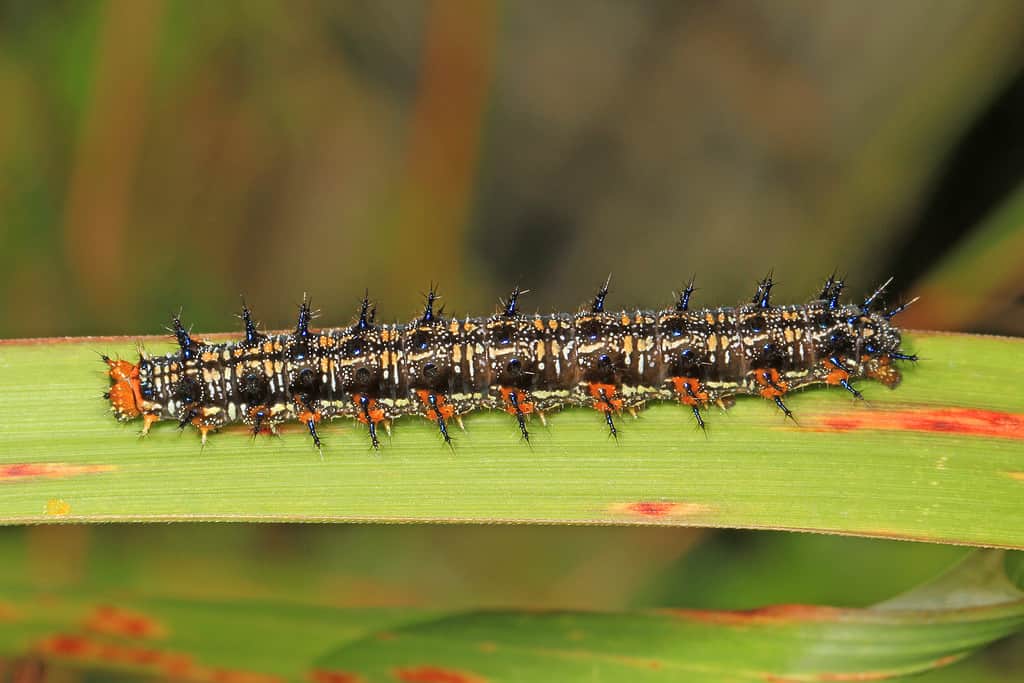
The common buckeye is, well, common around South Carolina.
This little butterfly is a frequent visitor to South Carolina gardens and orchards, but its caterpillar is found in roadsides, abandoned places, marshlands, and open fields. This caterpillar, which grows to 1.77 inches, has a long, cylindrical body. Though its coloring can vary, it’s usually black above, white or orange on the side with a pale stripe running down its back. It also has blue-black dorsal spines with a metallic sheen, but they’re harmless. The caterpillar also has spines down its sides that grow from structures that resemble warts. Its head is orange and black with white tubercles, and it also has orange prolegs. The common buckeye caterpillar prefers members of the snapdragon and acanthus families as food plants.
9. Mourning Cloak

The butterfly of the mourning cloak caterpillar has wings that seem edged with gold paint.
©Massimiliano Paolino/Shutterstock.com
The caterpillars of the state insect of Montana like to live in groups. They’ll feed on the same plant, sometimes stripping it of leaves, and leave the plant en masse when it’s time to pupate. This happens when the caterpillars are about 2.17 inches long.
These caterpillars have long black bodies bearing white dots and short hairs. They have larger red spots down their back that bear long spines, and their prolegs are red. You’ll find them in city parks, yards, at the edges of the woods, and in wetlands. There can be several broods a year in South Carolina.
The mourning cloak caterpillar uses birch, willows, elms, poplars, hawthorns, and hackberries as food plants.
10. Eastern Tiger Swallowtail
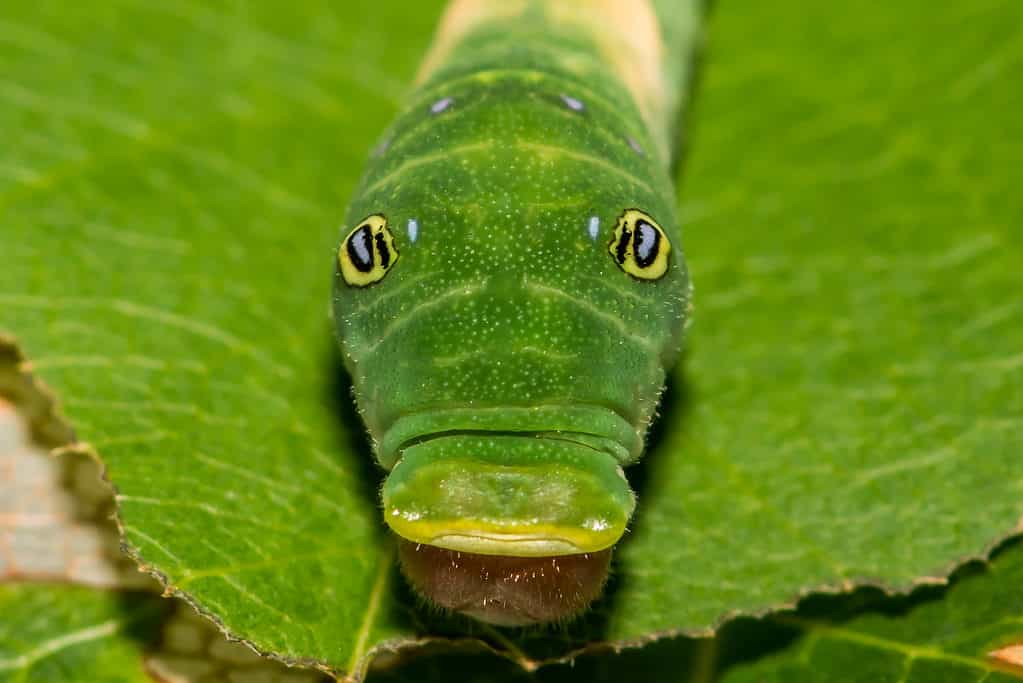
The eastern tiger swallowtail caterpillar scares off predators by mimicking a snake’s head.
©Jay Ondreicka/Shutterstock.com
The first three instars of this big, beautiful butterfly look nothing like the last instars. The caterpillar starts out life looking like a bird dropping. By the fourth instar, it looks more like a fat worm with smooth green skin, a thick thorax, and a tapering abdomen. The green color grows paler below the caterpillar’s spiracles, which helps camouflage it from predators. There is a pair of eyespots over the third segment of its thorax that makes the front of the caterpillar resemble a snake. The first segment of the abdomen has a yellow bar that you can’t see when the caterpillar is resting. There are also lavender spots above its spiracles and below its back. The caterpillar grows to be 2.17 inches long before it’s ready to pupate.
The eastern tiger swallowtail caterpillar is found in fields, in roadside trees, near bodies of water, and in the woods and forests. There are usually two broods and sometimes a third in South Carolina. The caterpillar is partial to magnolias, lilacs, willows, sweetbays, tulip trees, and cherry trees as food plants.
11. Cecropia Moth

The cecropia moth caterpillar’s spectacular colors warn predators that it is distasteful.
©K Hanley CHDPhoto/Shutterstock.com
Another giant silk moth, the caterpillar of this huge and gorgeous insect resembles the caterpillar of the luna moth, except it is a darker green and the green has a frosted sheen to it. It is also adorned with glossy yellow, blue, and orange knobs that make it look like a weird toy. It also has unusually robust prolegs. A big caterpillar, it can grow to nearly 4 inches in length before it’s ready to pupate.
You can find the cecropia moth caterpillar in yards, urban and suburban parks, orchards, forests, woods, and abandoned lots. It uses apples, box elders, lilacs, willows, and many other plants and trees for food.
12. Io Moth
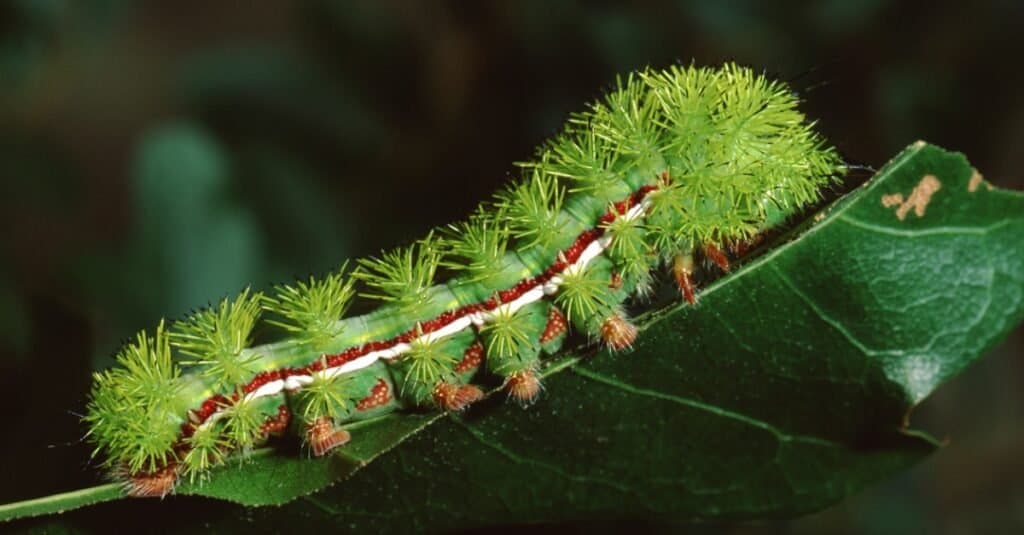
You can see the stinging hairs on this pretty Io moth caterpillar.
©iStock.com/Weber
The caterpillar of the beautiful Io moth is poisonous. It is apple green, with a red and white stripe down the sides and stinging spines on its back and sides. The first instars are brown and communal. They are orange or orange, brown in their next molt, beige with the red and white stripe in the next and finally, they molt into the green instar. Another sizable caterpillar, it grows to 2.5 inches long.
The Io moth caterpillar is found in fields, woods, river and creek banks, and forests. It uses a variety of plants for food, including willow, sassafras, grasses, oaks, and poplars.
Thank you for reading! Have some feedback for us? Contact the AZ Animals editorial team.

